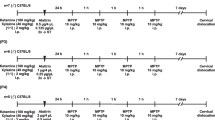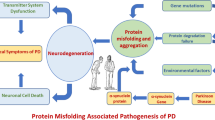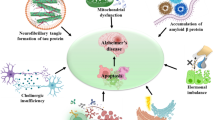Abstract
Cypermethrin induces the mitochondrial dysfunction and oxidative damage to the nigrostriatal dopaminergic neurons leading to Parkinsonism in rats. Despite α-synuclein aggregation is reported to be critical in Parkinson’s disease, its role and alliance with the mitochondrial dysfunction and oxidative damage leading to cypermethrin-induced Parkinsonism have not yet been deciphered. The present study aimed to examine the effect of cypermethrin on the expression and aggregation of α-synuclein and its subsequent connection with oxidative damage and mitochondrial dysfunction leading to the nigrostriatal dopaminergic neurodegeneration in the presence or absence of a mitochondrial membrane transition pore opening inhibitor, cyclosporine A and a superoxide dismutase/catalase mimetic, manganese (III) tetrakis (1-methyl-4-pyridyl) porphyrin pentachloride (MnTMPyP). The expression of α-synuclein, 3-nitrotyrosine (3-NT), 4-hydroxynonenal (4-HNE)-modified proteins, mitochondrial dysfunction-dependent apoptotic proteins, nitrite content, lipid peroxidation (LPO) and number of tyrosine hydroxylase (TH)-positive neurons were estimated in the substantia nigra and dopamine content in the striatum of control and treated rats employing standard procedures. Cypermethrin augmented the expression of α-synuclein, 3-NT, 4-HNE-modified proteins, caspase-3, mitochondrial Bax and cytosolic cytochrome-c along with nitrite and LPO and reduced the expression of cytosolic Bax, mitochondrial cytochrome-c, dopamine and number of TH-positive neurons. Cyclosporine A or MnTMPyP alleviated the expression and aggregation of α-synuclein along with indicators of the mitochondrial dysfunction, oxidative damage and dopaminergic neurodegeneration. The results demonstrate that cypermethrin induces α-synuclein expression and aggregation while cyclosporine A or MnTMPyP rescues from α-synuclein over-expression and aggregation along with the mitochondrial dysfunction and oxidative damage leading to Parkinsonism in rats.





Similar content being viewed by others
References
Mishra AK, Ur Rasheed MS, Shukla S, Tripathi MK, Dixit A, Singh MP (2014) Aberrant autophagy and Parkinsonism: does correction rescue from disease progression? Mol Neurobiol. doi:10.1007/s12035-014-8744-3
Singh MP, Patel S, Dikshit M, Gupta YK (2006) Contribution of genomics and proteomics in understanding the role of modifying factors in Parkinson’s disease. Indian J Biochem Biophys 43:69–81
Spillantini MG, Schmidt ML, Lee VM, Trojanowski JQ, Jakes R, Goedert M (1997) Alpha-synuclein in Lewy bodies. Nature 388:839–840
Norris EH, Giasson BI, Lee VM (2004) α-synuclein: normal function and role in neurodegenerative diseases. Curr Top Dev Biol 60:17–54
Yadav S, Dixit A, Agrawal S, Singh A, Srivastava G, Singh AK, Srivastava PK, Prakash O, Singh MP (2012) Rodent models and contemporary molecular techniques: notable feats yet incomplete explanations of Parkinson’s disease pathogenesis. Mol Neurobiol 46:495–512
Singh AK, Tiwari MN, Prakash O, Singh MP (2012) A current review of cypermethrin-induced neurotoxicity and nigrostriatal dopaminergic neurodegeneration. Curr Neuropharmacol 10:64–71
Singh AK, Tiwari MN, Upadhyay G, Patel DK, Singh D, Prakash O, Singh MP (2012) Long term exposure to cypermethrin induces nigrostriatal dopaminergic neurodegeneration in adult rats: postnatal exposure enhances the susceptibility during adulthood. Neurobiol Aging 33:404–415
Agrawal S, Singh A, Tripathi P, Mishra M, Singh PK, Singh MP (2014) Cypermethrin-induced nigrostriatal dopaminergic neurodegeneration alters the mitochondrial function: a proteomics study. Mol Neurobiol. doi:10.1007/s12035-014-8696-7
Gillette JS, Bloomquist JR (2003) Differential up-regulation of striatal dopamine transporter and alpha-synuclein by the pyrethroid insecticide permethrin. Toxicol Appl Pharmacol 192:287–293
Lee HJ, Shin SY, Choi C, Lee YH, Lee SJ (2002) Formation and removal of alpha-synuclein aggregates in cells exposed to mitochondrial inhibitors. J Biol Chem 277:5411–5417
Danielson SR, Andersen JK (2008) Oxidative and nitrative protein modifications in Parkinson’s disease. Free Radic Biol Med 44:1787–1794
Uttara B, Singh AV, Zamboni P, Mahajan RT (2009) Oxidative stress and neurodegenerative diseases: a review of upstream and downstream antioxidant therapeutic options. Curr Neuropharmacol 7:65–74
Lee CS, Park WJ, Ko HH, Han ES (2006) Differential involvement of mitochondrial permeability transition in cytotoxicity of 1-methyl-4-phenylpyridinium and 6-hydroxydopamine. Mol Cell Biochem 289:193–200
Matsuura K, Makino H, Ogawa N (1997) Cyclosporin A attenuates the decrease in tyrosine hydroxylase immunoreactivity in nigrostriatal dopaminergic neurons and in striatal dopamine content in rats with intrastriatal injection of 6-hydroxydopamine. Exp Neurol 146:526–535
Dixit A, Srivastava G, Verma D, Mishra M, Singh PK, Prakash O, Singh MP (2013) Minocycline, levodopa and MnTMPyP induced changes in the mitochondrial proteome profile of MPTP and maneb and paraquat mice models of Parkinson’s disease. Biochim Biophys Acta 1832:1227–1240
Yousuf S, Atif F, Kesherwani V, Agrawal SK (2011) Neuroprotective effects of tacrolimus (fk-506) and cyclosporin (CsA) in oxidative injury. Brain Behav 1:87–94
Mbye LH, Singh IN, Carrico KM, Saatman KE, Hall ED (2009) Comparative neuroprotective effects of cyclosporin A and NIM811, a nonimmunosuppressive cyclosporin A analog, following traumatic brain injury. J Cereb Blood Flow Metab 29:87–97
Srivastava G, Dixit A, Yadav S, Patel DK, Prakash O, Singh MP (2012) Resveratrol potentiates cytochrome P450 2 d22-mediated neuroprotection in maneb- and paraquat-induced parkinsonism in the mouse. Free Radic Biol Med 52:1294–1306
Chu Y, Kordower JH (2007) Age-associated increases of alpha-synuclein in monkeys and humans are associated with nigrostriatal dopamine depletion: is this the target for Parkinson’s disease? Neurobiol Dis 25:134–149
Tiwari MN, Singh AK, Ahmad I, Upadhyay G, Singh D, Patel DK, Singh C, Prakash O, Singh MP (2010) Effects of cypermethrin on monoamine transporters, xenobiotic metabolizing enzymes and lipid peroxidation in the rat nigrostriatal system. Free Radic Res 44:1416–1424
Gupta SP, Patel S, Yadav S, Singh AK, Singh S, Singh MP (2010) Involvement of nitric oxide in maneb- and paraquat-induced Parkinson’s disease phenotype in mouse: is there any link with lipid peroxidation? Neurochem Res 35:1206–1213
Lowry OH, Rosebrough NJ, Farr AL, Randall RJ (1951) Protein measurement with the Folin phenol reagent. J Biol Chem 193:265–275
Tiwari MN, Singh AK, Agrawal S, Gupta SP, Jyoti A, Shanker R, Prakash O, Singh MP (2012) Cypermethrin alters the expression profile of mRNAs in the adult rat striatum: a putative mechanism of postnatal pre-exposure followed by adulthood re-exposure-enhanced neurodegeneration. Neurotox Res 22:321–334
Klucken J, Ingelsson M, Shin Y, Irizarry MC, Hedley-Whyte ET, Frosch M, Growdon J, McLean P, Hyman BT (2006) Clinical and biochemical correlates of insoluble alpha-synuclein in dementia with Lewy bodies. Acta Neuropathol 111:101–108
Cannon JR, Tapias V, Na HM, Honick AS, Drolet RE, Greenamyre JT (2009) A highly reproducible rotenone model of Parkinson’s disease. Neurobiol Dis 34:279–290
Kanaan NM, Kordower JH, Collier TJ (2008) Age-related changes in dopamine transporters and accumulation of 3-nitrotyrosine in rhesus monkey midbrain dopamine neurons: relevance in selective neuronal vulnerability to degeneration. Eur J Neurosci 27:3205–3215
Lv C, Hong T, Yang Z, Zhang Y, Wang L, Dong M, Zhao J, Mu J, Meng Y (2012) Effect of Quercetin in the 1-methyl-4-phenyl-1, 2, 3, 6-tetrahydropyridine-induced mouse model of Parkinson’s disease. Evid Based Complement Alternat Med 2012:928643
Sutachan JJ, Casas Z, Albarracin SL, Stab BR, Samudio I, Gonzalez J, Morales L, Barreto GE (2012) Cellular and molecular mechanisms of antioxidants in Parkinson’s disease. Nutr Neurosci 15:120–126
Sharma SS, Gupta S (2007) Neuroprotective effect of MnTMPyP, a superoxide dismutase/catalase mimetic in global cerebral ischemia is mediated through reduction of oxidative stress and DNA fragmentation. Eur J Pharmacol 561:72–79
Kumar P, Kalonia H, Kumar A (2010) Cyclosporine A attenuates 3-nitropropionic acid-induced Huntington-like symptoms in rats: possible nitric oxide mechanism. Int J Toxicol 29:318–325
Banerjee K, Sinha M, Pham Cle L, Jana S, Chanda D, Cappai R, Chakrabarti S (2010) Alpha-synuclein induced membrane depolarization and loss of phosphorylation capacity of isolated rat brain mitochondria: implications in Parkinson’s disease. FEBS Lett 584:1571–1576
Borlongan CV, Emerich DF, Hoffer BJ, Bartus RT (2002) Bradykinin receptor agonist facilitates low-dose cyclosporine-A protection against 6-hydroxydopamine neurotoxicity. Brain Res 956:211–220
Pong K, Rong Y, Doctrow SR, Baudry M (2002) Attenuation of zinc-induced intracellular dysfunction and neurotoxicity by a synthetic superoxide dismutase/catalase mimetic, in cultured cortical neurons. Brain Res 950:218–230
Nilakantan V, Liang HL, Rajesh S, Mortensen J, Chandran K (2010) Time-dependant protective effects of mangenese (III) tetrakis (1-methyl-4-pyridyl) porphyrin on mitochondrial function following renal ischemia-reperfusion injury. Free Radic Res 44:773–782
Xie Z, Lei B, Huang Q, Deng J, Wu M, Shen W, Cheng Y (2012) Neuroprotective effect of cyclosporin A on the development of early brain injury in a subarachnoid hemorrhage model: a pilot study. Brain Res 1472:113–123
Acknowledgments
The authors are grateful to the Council of Scientific and Industrial Research (CSIR), New Delhi, India, for providing research fellowship to Sonal Agrawal. Furthermore, the Department of Biotechnology, New Delhi, India, and CSIR, New Delhi, India are gratefully acknowledged for the financial support (BT/PR14382/MED/12/474/2010 and miND/BSC0115) to the study. The CSIR-IITR communication number of this article is 3245.
Conflict of Interest
The authors declare that they do not have any conflicts of interest.
Author information
Authors and Affiliations
Corresponding author
Rights and permissions
About this article
Cite this article
Agrawal, S., Dixit, A., Singh, A. et al. Cyclosporine A and MnTMPyP Alleviate α-Synuclein Expression and Aggregation in Cypermethrin-Induced Parkinsonism. Mol Neurobiol 52, 1619–1628 (2015). https://doi.org/10.1007/s12035-014-8954-8
Received:
Accepted:
Published:
Issue Date:
DOI: https://doi.org/10.1007/s12035-014-8954-8




